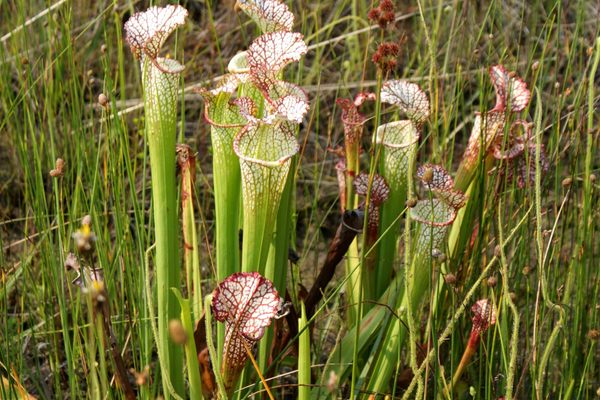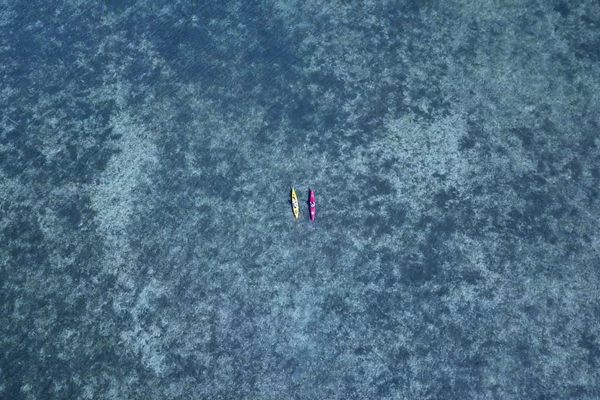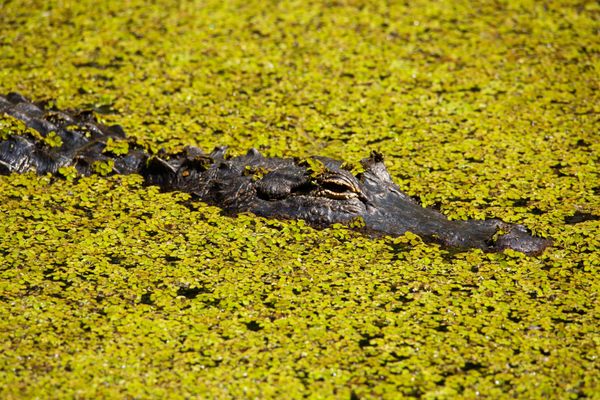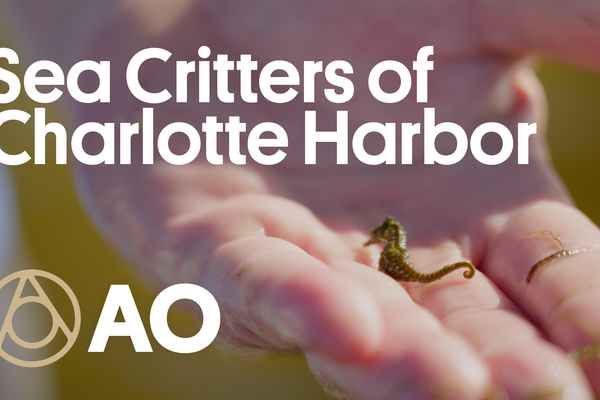
Aquatic Adventures: 7 Spots for Diving, Snorkeling, and Wildlife in Florida
Discover the amazing underwater world that can be experienced only in the Sunshine State.
If the water calls to you, you can’t do better than Florida, with its more than 8,400 miles of coastline and varying habitats where an incredible collection of fish, amphibians, and mammals dwell. Eric Hovland, animal care specialist for The Florida Aquarium in Tampa, fell in love with the state when he visited as a child and has called it home for 30 years, drawn by its staggering array of wildlife. “Florida is one of my favorite places to adventure. There are a bunch of biomes that you won’t find anywhere else in the nation, from mangroves to the coral reefs,” he says. “Beyond the Atlantic Coast and the Gulf Coast, we have the ‘third coast,’ the [freshwater] springs where you can dip into the crystal-clear water bubbling up from the aquifer under the surface.”
Another asset? “Nobody in Florida is more than an hour away from the coast,” Hovland says. Whether you’re a certified diver looking to challenge yourself or are curious about snorkeling to see some of Florida’s underwater wonders, such as historic shipwrecks, hidden caves, and the only place in the U.S. to swim with manatees, this is the guide to get you started.
1. Crystal River
Whether you call them sea cows, mermaids, or manatees (their proper name), these gentle giants can weigh 1,000 pounds or more and stretch to 10 feet long and longer. They tend to be a highlight for aquatic watchers, and one of the best places to see them up close is the seven-mile-long Crystal River, where the impeccably clear water hovers around 72 degrees year-round (comfy for the sea mammals, but chilly for humans, so wear a wetsuit). The destination has the designation of being the only place in the United States where visitors can legally interact with manatees, with very specific instructions about how to be respectful, since many of the gentle giants are curious and may want to play and interact with snorkelers. “The Florida manatee, [also known as] the West Indies manatee, is still an animal that requires our protection,” Hovland says of the species currently categorized as “threatened.” In addition to the river’s stars, keep your snorkel mask clear to spot ladyfish, spotted seatrout, redfish, rays, and tarpon darting in and out of the gentle waves.

2. Devil’s Den Spring
Devil’s Den Spring in Williston gets its eerie name thanks to the steam that can be seen rising from the underground cave during chilly mornings. Hovland, who completed a dive certification here, calls it “otherworldly.” Estimated to be 10,000 years old, it’s considered a “prehistoric spring,” the karst landscape of which has been carved out as water has dissolved the soluble bedrock over millennia. Lucky divers in the area have found fossils that date back to the Pleistocene age. These days, this natural treasure is owned by a private snorkeling and diving company and visitors can explore its clear, watery depths by reservation. Snorkelers descend the staircase, plunge into the 72-degree water, and start exploring to spot stalactites, ancient rock formations, and hanging plants overhead.

3. John Pennekamp Coral Reef State Park
When you hear “state park” you might be inclined to envision dry land, so this is unexpected. Established in 1963 as the first undersea park in the U.S., John Pennekamp Coral Reef State Park protects 70 nautical square miles, as the Florida Keys are home to the continental United State’s only living coral reef. The crystalline waters are home to approximately 80 species of coral, including the impressive brain coral, mountainous star coral, and sea fans, as well as more than 260 species of tropical fish, plus urchins, sea cucumber, brittle starfish, and spiny lobster. Stay dry and see the sights on a glass-bottom boat tour of the park or join one of the snorkel boat trips that depart four times per day (the park offers excursions aboard The Encounter, a wheelchair-accessible snorkeling vessel).

4. Dry Tortugas National Park
In 1513, when Juan Ponce de León first encountered the group of islands about 70 miles west of Key West, the main inhabitants were the sea turtles that inspired the name “Las Tortugas.” “Dry” was added later to convey that there are no freshwater sources in the area. Thanks to a prime location between the Atlantic Ocean and the Gulf of Mexico, Dry Tortugas became a fixture on trade routes, but with its shallow depths, hundreds of ships ran aground. In the early 19th century, the U.S. built the Fort Jefferson naval station, made of 16 million bricks, on Garden Key Island.. Though the fort was abandoned by the military in 1874, it was designated as a National Monument in 1935. Now, it’s the centerpiece of Dry Tortugas National Park. Accessible only via seaplane or boat, less than 1% of the 100-square-mile-park is dry land, so the best way to experience it is by snorkeling, swimming, and diving. Abundant shipwrecks create artificial reefs and visitors are likely to see reef squid, nurse sharks, hogfish, barracuda, and giant grouper.

5. Ginnie Springs
When famed French oceanographer and filmmaker Jacques Cousteau endorses a diving location as having “visibility forever,” you know it’s something special. Named for a woman who once did her laundry in these shockingly clear waters, this locale 45 minutes northwest of Gainesville is a prime spot for snorkeling and diving. Comprised of six springs, it was once a settlement of the native Timucua people and it’s not uncommon for divers to find artifacts such as arrowheads, flint, and broken pottery. The water remains approximately 72 degrees year-round, and snorkelers often spot catfish, turtles, bass, and other lively underwater residents. For certified divers, there is an array of places to explore, including Devil’s Ear, Devil Spring, and Devil’s eye, all of which enforce a strict no-light rule to preserve the environment and protect less-experienced divers from trouble.
6. Alligator Reef Lighthouse
To get to this stunning spot four nautical miles west of Islamorada in the Florida Keys, you’ll want to hire a local captain, though some strong kayakers have also been known to make the trek. And don’t worry: this hauntingly beautiful spot isn’t gator-infested as the name might suggest. Instead, it was named for the USS Alligator, a 1822 Navy schooner tasked with protecting the state’s southernmost waters from pirates. However, not long after the Alligator set sail, it ran aground on a reef and sank in the shallow waters, joining other boats that made similar mistakes. A 133-foot-tall lighthouse was built in 1873 to help other sailors avoid the same fate. Now, it’s a prime destination for snorkeling and scuba diving, thanks to impeccably clear water and colorful coral that ranges from 8 to 40 feet below the surface. It plays home to spiny lobsters, parrotfish, barracuda, angelfish, porcupine fish, and the occasional hammerhead shark.
7. Underwater Museum of Art
Opened in 2018, the first permanent underwater sculpture garden in the U.S. is a prime example of artful conservation. Just under a mile off the shore of Grayton Beach State Park in northwestern Florida and 58 feet below the surface of the Gulf of Mexico, 47 sculptures from artists around the world are installed on the sea bottom. Guests can see an amorphous octopus, abstract seahorses, and an eerie skull, all of which act as artificial reefs that become part of the aquatic landscape, attracting marine life and transforming into a living reef over time. Such a project epitomizes innovative eco-tourism, as it attracts more than 100 aquatic species such as an array of algae, bottlenose dolphins, green sea turtles, nurse sharks, belted sandfish, and more. There’s always a reason to return: new sculptural pieces, selected by a jury, are installed each year. The museum is free to visit, but there is an admission fee to Grayton Beach State Park. Currently, the only way to visit the museum is by diving (read: you’d need to be certified). However, snorkelers can get an overhead view of the sculptures and the curious fish that populate the area.
Sponsored by VISIT FLORIDA.





















































Follow us on Twitter to get the latest on the world's hidden wonders.
Like us on Facebook to get the latest on the world's hidden wonders.
Follow us on Twitter Like us on Facebook